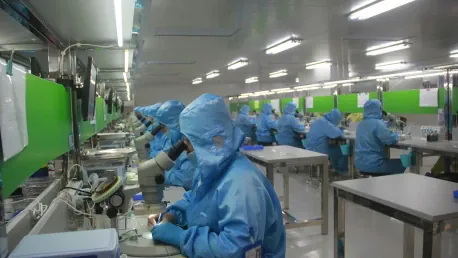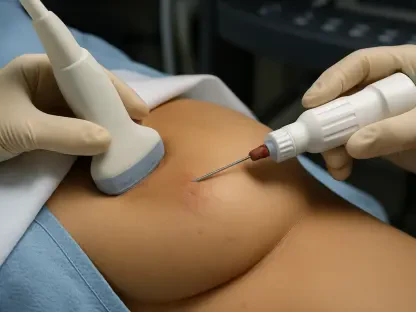Johnson & Johnson’s commitment to investing $55 billion in U.S. manufacturing, research, and development over the next four years marks a significant expansion for the renowned pharmaceutical company. Announced by CEO Joaquin Duato on March 21, this ambitious initiative is intended to bolster the company’s pharmaceutical and medical technology businesses. Key elements of this substantial investment include the establishment of three advanced manufacturing facilities and the expansion of existing sites. One of the most notable developments is the groundbreaking of a new 500,000-square-foot biologics manufacturing facility in Wilson, North Carolina, projected to create 5,000 construction jobs and 500 permanent positions.
The move by Johnson & Johnson clearly mirrors a broader trend among major pharmaceutical companies, including Eli Lilly, Merck & Co., and Amgen, which have emphasized their investment in U.S.-based manufacturing recently. These companies aim to alleviate tariff burdens and advocate for policy benefits such as extended tax cuts and softened Medicare price reductions. The overarching theme here involves the strategic re-shoring of manufacturing operations, influenced by the Tax Cut and Jobs Act of 2017. This legislation reduced the base corporate tax rate and lowered taxes on profits earned abroad, fostering an environment conducive to domestic facility expansions.
Wider Industry Trends
Strategic Re-shoring of Manufacturing Operations
The trend of re-shoring manufacturing operations in the pharmaceutical industry has been largely enabled by tax legislation. Companies are driven by the need to mitigate tariff risks associated with overseas production and to adhere to governmental emphasis on “America first” policies aimed at spurring domestic job creation. Johnson & Johnson’s move is set to impact the pharmaceutical landscape and reinforce its economic contributions, which it claims already exceed $100 billion annually.
Other pharmaceutical giants such as Eli Lilly, Merck & Co., and Amgen have similarly pivoted towards significant investments in U.S. manufacturing. This shift is seen as a strategic maneuver to leverage policy benefits, including extended tax cuts and softened Medicare price reductions. Such legislative changes, particularly the Tax Cut and Jobs Act, have markedly reduced the corporate tax rate and lowered taxes on overseas profits. This has fostered an encouraging environment for companies to expand their domestic facilities and invest substantially within the U.S.
Legislative Influence
The Tax Cut and Jobs Act of 2017 played a substantial role in shaping the current landscape for pharmaceutical manufacturing. By reducing the base corporate tax rate and lowering taxes on profits earned abroad, it encouraged companies to undertake significant domestic investments. Johnson & Johnson’s expansion represents a marked increase in its investment compared to the previous four years. Between 2025 and 2028, the company plans to invest roughly $4 billion annually on capital expenditures related to property, plant, and equipment additions.
The legislative changes ushered in by the Tax Cut and Jobs Act have fostered a conducive environment for pharmaceutical companies to strategically re-shore their manufacturing operations. By lowering the base corporate tax rate and taxes on overseas profits, this legislation has provided companies like Johnson & Johnson, Eli Lilly, Merck & Co., and Amgen with viable incentives to enhance their domestic footprint. The decision to ramp up U.S.-based manufacturing not only mitigates the risks associated with international tariffs but also aligns with governmental policies aimed at boosting domestic job creation and economic growth.
J&J’s Expanding Pharmaceutical Capacity
Increased Production for High-Demand Products
Johnson & Johnson’s planned U.S. expansion represents a 25% increase in investment compared to the previous four years. During this period, the company’s annual reports indicated expenditures of approximately $4 billion annually on capital related to property, plant, and equipment additions. Demand for Johnson & Johnson’s fast-growing biologic medicines, such as Darazalex and Carvykti for cancer treatment, and Tremfya for psoriasis, further drives the necessity to enhance production capacity.
The increasing demand for Johnson & Johnson’s products, particularly biologic medicines like Darazalex, Carvykti, and Tremfya, underscores the need for expanded production capacity. Additionally, Eli Lilly’s success with its GLP-1 product tirzepatide, marketed as Ozempic for diabetes and Zepbound for obesity, exemplifies this trend. The surging sales of these innovative treatments necessitate substantial investments in manufacturing sites and technological enhancements to meet patient needs effectively.
Facility Expansion and Job Creation
Johnson & Johnson’s investment in the new biologics manufacturing facility in Wilson, North Carolina, speaks volumes about its commitment to expanding U.S. operations. This facility, set to cover 500,000 square feet, promises to create 5,000 construction jobs and 500 permanent positions. It underscores the company’s dedication to not only boosting its production capabilities but also contributing to the local economy and workforce development.
The development of the new biologics manufacturing facility in Wilson is poised to significantly impact local employment and economic growth. By creating thousands of construction jobs and hundreds of permanent positions, Johnson & Johnson is actively contributing to workforce training and development. Furthermore, the expansion of existing sites and establishment of additional manufacturing facilities demonstrates the company’s strategic positioning to meet growing market demands while reinforcing its substantial economic footprint.
Future Growth and Strategic Positioning
Enhancing Drug Discovery and Development
Future announcements from Johnson & Johnson are expected to detail additional manufacturing sites, expansions of research and development facilities, and increased technology investments. These efforts are aimed at accelerating drug discovery and development, supporting workforce training, and enhancing business operations. This strategic move reinforces Johnson & Johnson’s position in the pharmaceutical industry, ensuring sustained growth and operational excellence.
Johnson & Johnson’s proactive approach to expanding its U.S. footprint through substantial investments in manufacturing and research facilities signifies its commitment to innovation and operational efficiency. By channeling resources towards workforce training, technological enhancements, and accelerated drug discovery, the company is well-positioned to meet the demands of an evolving market and maintain its competitive edge. The establishment of advanced manufacturing facilities further solidifies Johnson & Johnson’s strategic positioning within the pharmaceutical sector.
Economic Impact and Industry Influence
Johnson & Johnson claims its economic contributions already exceed $100 billion annually. The planned investments underline the company’s dedication to reinforcing its impact within the pharmaceutical landscape. As the industry moves forward, additional announcements detailing expansions and technological advancements will further solidify Johnson & Johnson’s role as a pivotal player in the healthcare sector.
The substantial investment plans announced by Johnson & Johnson underscore its unwavering commitment to enhancing its economic footprint and industry influence. By consistently expanding its manufacturing and research capabilities, the company is set to play a pivotal role in shaping the future of the pharmaceutical sector. The anticipated announcements regarding additional sites and technological advancements will further establish Johnson & Johnson’s status as a leader in the healthcare industry.
Conclusion: Shaping the Future of Pharmaceutical Manufacturing
Johnson & Johnson’s pledge to invest $55 billion in U.S. manufacturing, research, and development over the next four years represents a major growth effort for this leading pharmaceutical company. Announced by CEO Joaquin Duato on March 21, this ambitious plan aims to strengthen its pharmaceutical and medical technology sectors. A key part of this investment includes building three advanced manufacturing facilities and enlarging existing sites. Notably, a new 500,000-square-foot biologics manufacturing facility in Wilson, North Carolina, will be constructed, creating 5,000 construction jobs and offering 500 permanent positions.
This strategy by Johnson & Johnson aligns with a broader trend among large pharmaceutical firms like Eli Lilly, Merck & Co., and Amgen, highlighting their focus on U.S.-based manufacturing. These companies aim to ease tariff pressures and seek policies like extended tax cuts and reduced Medicare price restrictions. The larger strategy involves re-shoring manufacturing, driven by the 2017 Tax Cut and Jobs Act, which lowered corporate tax rates and foreign profit taxes, promoting domestic expansion.









